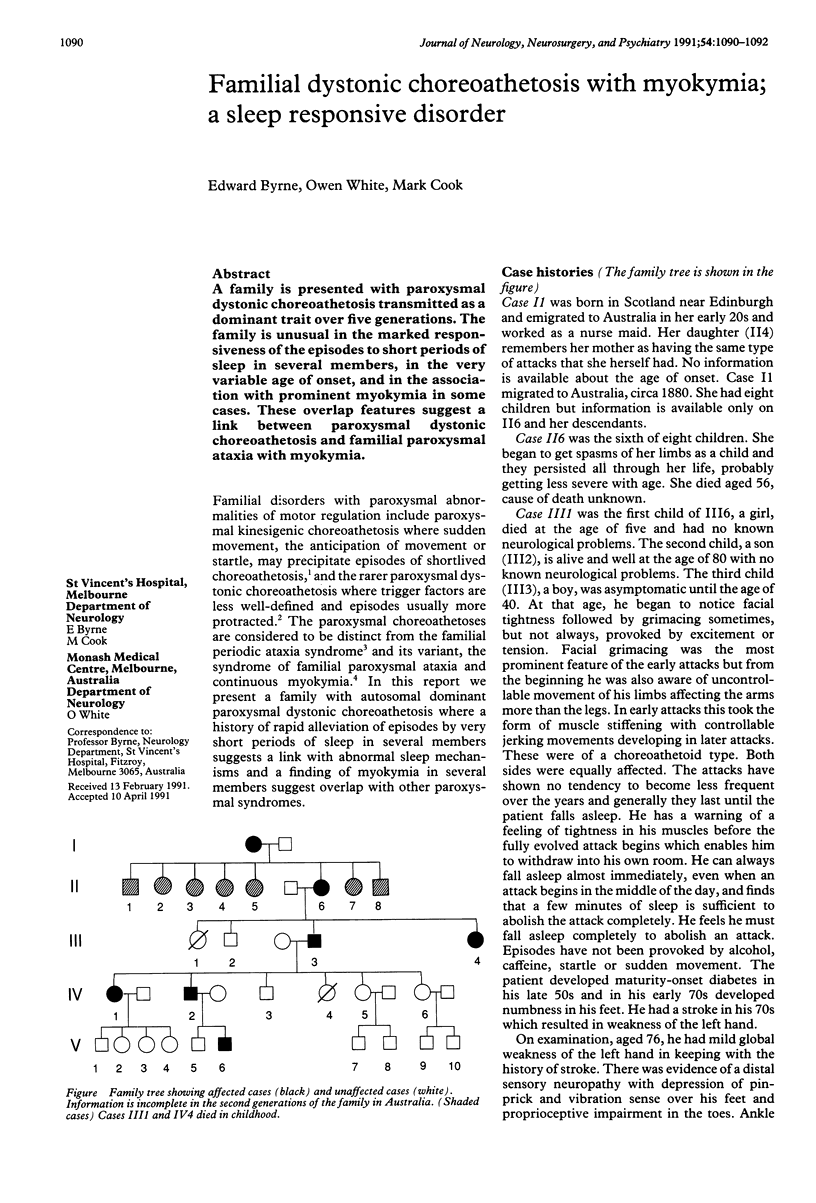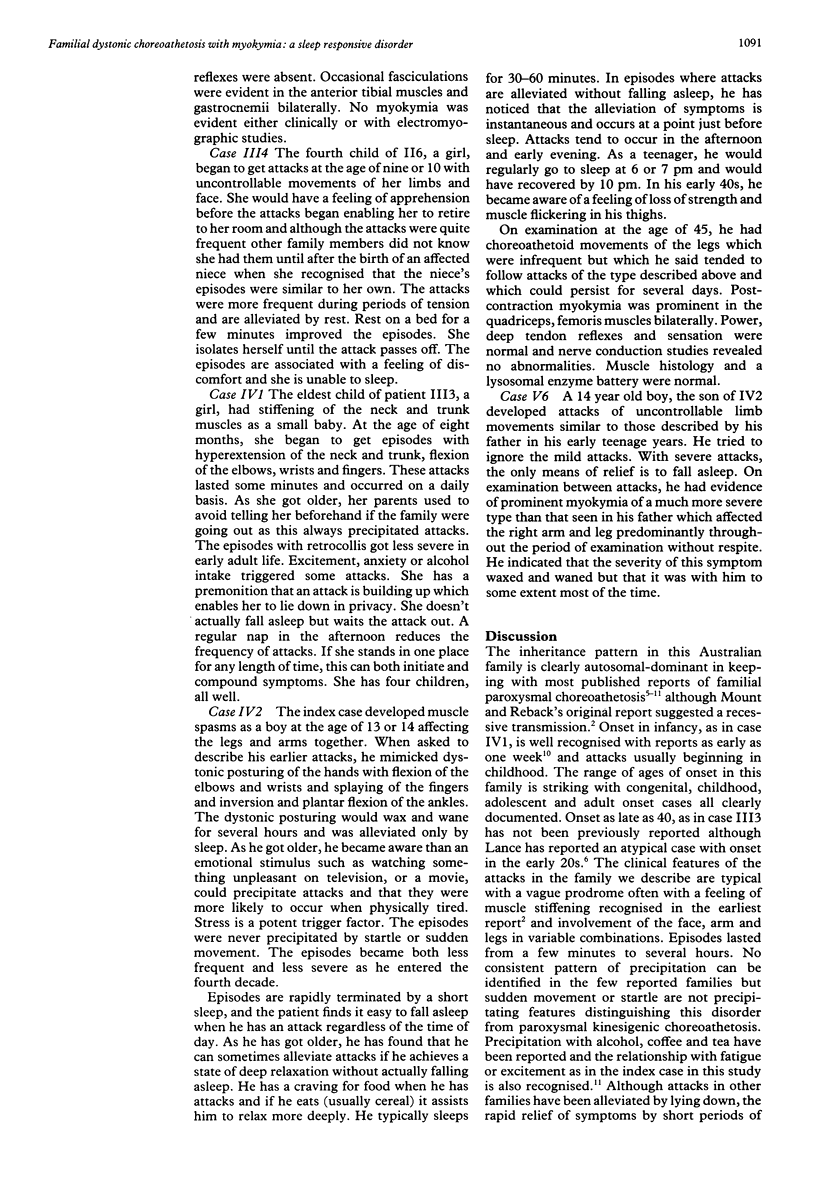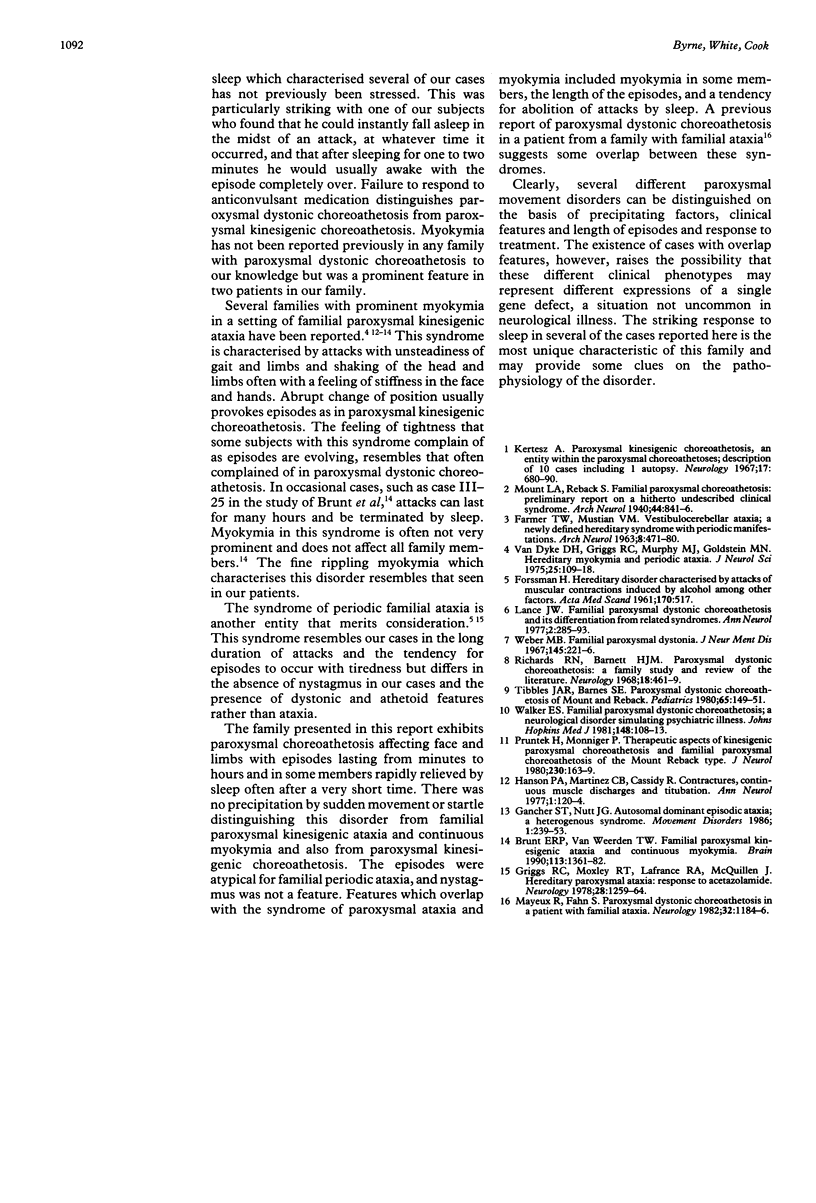Abstract
A family is presented with paroxysmal dystonic choreoathetosis transmitted as a dominant trait over five generations. The family is unusual in the marked responsiveness of the episodes to short periods of sleep in several members, in the very variable age of onset, and in the association with prominent myokymia in some cases. These overlap features suggest a link between paroxysmal dystonic choreoathetosis and familial paroxysmal ataxia with myokymia.
Full text
PDF


Selected References
These references are in PubMed. This may not be the complete list of references from this article.
- Brunt E. R., van Weerden T. W. Familial paroxysmal kinesigenic ataxia and continuous myokymia. Brain. 1990 Oct;113(Pt 5):1361–1382. doi: 10.1093/brain/113.5.1361. [DOI] [PubMed] [Google Scholar]
- FARMER T. W., MUSTIAN V. M. Vestibulocerebellar ataxia. A newly defined hereditary syndrome with periodic manifestations. Arch Neurol. 1963 May;8:471–480. doi: 10.1001/archneur.1963.00460050021002. [DOI] [PubMed] [Google Scholar]
- FORSSMAN H. Hereditary disorder characterized by attacks of muscular contractions, induced by alcohol amongst other factors. Acta Med Scand. 1961 Nov;170:517–533. doi: 10.1111/j.0954-6820.1961.tb00266.x. [DOI] [PubMed] [Google Scholar]
- Gancher S. T., Nutt J. G. Autosomal dominant episodic ataxia: a heterogeneous syndrome. Mov Disord. 1986;1(4):239–253. doi: 10.1002/mds.870010404. [DOI] [PubMed] [Google Scholar]
- Griggs R. C., Moxley R. T., 3rd, Lafrance R. A., McQuillen J. Hereditary paroxysmal ataxia: response to acetazolamide. Neurology. 1978 Dec;28(12):1259–1264. doi: 10.1212/wnl.28.12.1259. [DOI] [PubMed] [Google Scholar]
- Hanson P. A., Martinez L. B., Cassidy R. Contractures, continuous muscle discharges, and titubation. Ann Neurol. 1977 Feb;1(2):120–124. doi: 10.1002/ana.410010203. [DOI] [PubMed] [Google Scholar]
- Kertesz A. Paroxysmal kinesigenic choreoathetosis. An entity within the paroxysmal choreoathetosis syndrome. Description of 10 cases, including 1 autopsied. Neurology. 1967 Jul;17(7):680–690. doi: 10.1212/wnl.17.7.680. [DOI] [PubMed] [Google Scholar]
- Lance J. W. Familial paroxysmal dystonic choreoathetosis and its differentiation from related syndromes. Ann Neurol. 1977 Oct;2(4):285–293. doi: 10.1002/ana.410020405. [DOI] [PubMed] [Google Scholar]
- Mayeux R., Fahn S. Paroxysmal dystonic choreoathetosis in a patient with familial ataxia. Neurology. 1982 Oct;32(10):1184–1186. doi: 10.1212/wnl.32.10.1184. [DOI] [PubMed] [Google Scholar]
- Richards R. N., Barnett H. J. Paroxysmal dystonic choreoathetosis. A family study and review of the literature. Neurology. 1968 May;18(5):461–469. doi: 10.1212/wnl.18.5.461. [DOI] [PubMed] [Google Scholar]
- Tibbles J. A., Barnes S. E. Paroxysmal dystonic choreoathetosis of Mount and Reback. Pediatrics. 1980 Jan;65(1):149–151. [PubMed] [Google Scholar]
- VanDyke D. H., Griggs R. C., Murphy M. J., Goldstein M. N. Hereditary myokymia and periodic ataxia. J Neurol Sci. 1975 May;25(1):109–118. doi: 10.1016/0022-510x(75)90191-4. [DOI] [PubMed] [Google Scholar]
- Walker E. S. Familial paroxysmal dystonic choreoathetosis: a neurologic disorder simulating psychiatric illness. Johns Hopkins Med J. 1981 Mar;148(3):108–113. [PubMed] [Google Scholar]
- Weber M. B. Familial paroxysmal dystonia. J Nerv Ment Dis. 1967 Sep;145(3):221–226. doi: 10.1097/00005053-196709000-00005. [DOI] [PubMed] [Google Scholar]


